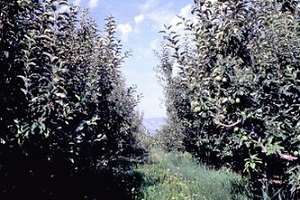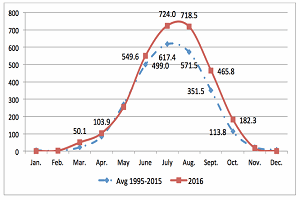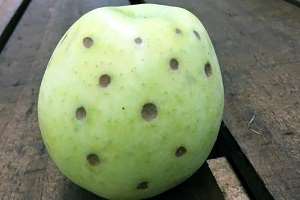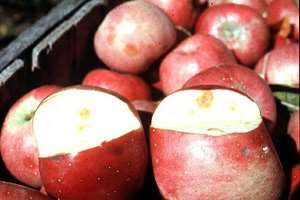We heard and saw many problems with calcium deficiencies in commercial orchards this past year. I thought it would be a good idea to review how the 2016 growing season may have impacted those problems.

First we need to look at the weather patterns for the season. Below is a graph of the monthly growing degree days (GDD) using a base of 50°F for our RainWise weather instrument at Rock Springs. The blue line represents the twenty year average for GDD at Rock Springs; while the red line represents the GDD for this past year.
There are two things to note in the graph. First is the little blip that occurred in March where we had more GDD than average. This ‘blip’ has occurred for the past 4 out of the last five years and was most pronounced in 2012 when we had one of our earliest blooming season resulting in essentially no crop in the Rock Springs orchards. The second point is the higher than monthly average GDD for July through September. All three months had monthly GDD accumulation of over 100 from the 20 year average; and May and October were also higher than average.

Figure 1. Growing degree days base 50°F for 2016 versus average for 1995 through 2015 at Rock Springs, PA.
How did this potentially exacerbate calcium problems this year? First, calcium in fruit trees moves primarily in the xylem in the transpiration stream. Hot dry conditions could favor greater movement of water in this stream which primarily goes to the leaves and less so to the fruit. It was estimated that only 5 to 10% of root absorbed calcium moves into the fruit (Wojck, 2004).
Calcium is generally considered non-mobile once it enters the tree, therefore, foliar applications of calcium products are an important cultural practice in a multi-faceted calcium enhancement program in orchards. With limited lateral movement within the tree it is important that calcium sprays must come into contact with the fruit. Eichert (2013) indicates for the plant to absorb a foliar nutrient it must overcome the barrier properties of leaf(/fruit) surfaces to be effective. To achieve this there must be a concentration gradient across the leaf(/fruit) surface.
The environmental conditions at application play a factor on how much of the foliar spray can be absorbed. Under fast drying conditions, hot & dry like this summer, once the solution is dry little absorption can occur. Applications of foliar nutrients such as calcium in the late afternoon or low humidity conditions may have less of a chance to be absorbed. At the same time calcium products that are hygroscopic, like CaCl2, may remain in solution for a longer period and potentially have a longer period to be absorbed. The addition of wetting agents or other surfactants can also affect absorption (Harker & Ferguson, 1991). Other factors suggested to predispose fruit to development of bitter pit include general water stress and interrelationship with gibberellins late in the season (Saure, 1996).

Some other factors that may have impacted occurrence of calcium related problems. Many growers utilize alternate row middle (ARM) sprays for their cover sprays. In a normal year this may work fine but in a year like this last it did not seem to work as well. To be effective the calcium has to hit the fruit with big dense trees the spray may not have reached as much of the apple surface this season. Some areas had lighter crops than normal this year due to spring frosts.
Large fruit from lightly cropped trees and excessive shoot growth would be more susceptible to calcium deficiency problems. Work Tara Baugher and Rich Marini have been doing have shown there appears to be a relationship with N, K and possibly Mg levels within the tree and/or the fruit that can make calcium problems more prevalent. We also believe that different cultivars probably have a greater or lesser need for calcium. Case in point lately seems to be Honeycrisp. Rootstocks also influence calcium uptake. Many years ago we found that Delicious grafted on M.9 rootstocks had higher foliar levels of Ca than the same strain grafted on M.7, M.26 or MM111 (Crassweller & Ferree, 1984). This is also the subject of a SARE grant that I am currently working on looking at the new Geneva rootstocks in Adams County.

It would appear that many orchards had one of the “perfect storm” type of seasons. The normal routine and rate of foliar calcium sprays was just not enough in the face of the growing conditions for this year. Given the erratic weather patterns we have had in the last few years may necessitate a reevaluation of your calcium deficiency mitigation practices with an increased attention to detail.
Source: psu.edu